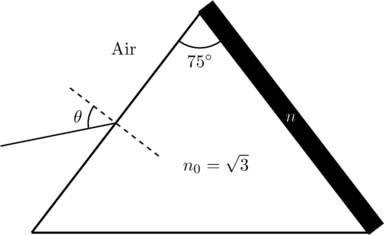JEE Advanced 2017 Paper 1, Question 10
A monochromatic light is traveling in a medium of refractive index ![]() . It enters a stack of glass layers from the bottom side at an angle
. It enters a stack of glass layers from the bottom side at an angle ![]() . The interfaces of the glass layers are parallel to each other. The refractive indices of different glass layers are monotonically decreasing as
. The interfaces of the glass layers are parallel to each other. The refractive indices of different glass layers are monotonically decreasing as ![]() , where
, where ![]() is the refractive index of the
is the refractive index of the ![]() slab and
slab and ![]() (see the figure). The ray is refracted out parallel to the interface between the
(see the figure). The ray is refracted out parallel to the interface between the ![]() and
and ![]() slabs from the right side of the stack. What is the value of
slabs from the right side of the stack. What is the value of ![]() ?
?

Solution
Consider the trajectory of …


